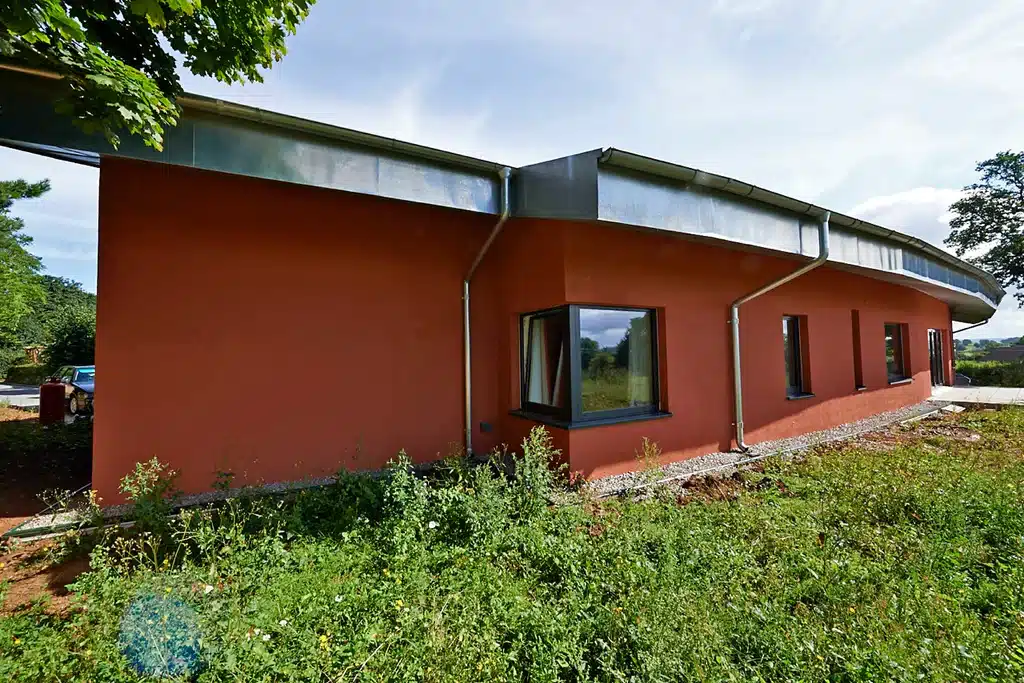SPECIFICATION GENERATOR
Find out which low impact materials are right for your building project.
Silverton Passive House, Devon
Find out more about how we approach this building scenario.
A light, spacious, gently curving Passive House Certified home with contemporary architectural features and built with natural materials. It performs amazingly well, whether in bitterly cold winds or in a heat wave!!
This family home is a re-development of a 1950’s bungalow set in the Devon countryside. The existing bungalow was stripped, demolished and crushed into hardcore to use under the new house. Planning restrictions meant that building up was not allowed so they went down into the ground.
The basement was built using Logixx ICF (insulated concrete formwork) with tanking. Above ground, the house uses a timber frame construction with 300mm I-beams in the roof. Because of the slightly unorthodox shape of the building U-Values for the walls are around 0.1W/m2K and for the roof are down to 0.09W/m2K, which enabled the house the achieve Passive House certification.

What materials were used?
The house uses a 300mm layer of UdiFLEX flexible wood fibre insulation in the walls and roof and a 100mm layer of UdiTHERM wood fibre board over this. On the roof, this was covered by a 60mm UdiTOP wood fibre board and eventually finished with Zinc. The boldly coloured walls use a 40mm UdiSPEED wood fibre board over the UdiTHERM, finished with the UdiPERL render system. In spite of concerns over the practicality of such a strong coloured self-coloured render, should the render get scratched or marked it is very easily and invisibly repaired.
Internally, for the airtightness, around 6000m of UdiSTEAM Elastoflex airtightness tape was used to tape the OSB boards and to tape around the concrete slab edges. Around 600 m2 of 22mm EBB clay boards were also used in the internal partition walls to increase the thermal mass of the building. It also helps with acoustic insulation between rooms which are traditionally a problem in timber-framed houses.
What did we do?
We helped design the construction of the walls and roof, confirming U-Values and checking the build-up with condensation risk analyses to confirm the suitability of the design. Working with the architects we designed the detailing for all of the junctions, ensuring thermal bridges were avoided and also designed the airtightness scheme for the building.
A separate office building which was built first was used as a training opportunity for the construction team. This helped them understand what was required of them in terms of airtightness and the taping required on the OSB airtight layer. An air test achieving 0.63 ach (in spite of a service duct not being sealed) confirmed that the team had a good grasp of what was required.
There was a lot of input from us on this project in terms of ensuring airtightness as the frame was erected, that the wood fibre insulation materials were fitted correctly and that all the airtightness products were used correctly internally. The final airtightness of 0.265 ach was the proof that with our input the project achieved excellent results.
There are lots of construction photos here on our Flickr site or see the timelapse videos of the build above. The SAP calculations for the house are available here or for the performance data being produced go to our resources page here. The house is currently consuming around 18500 kWh per annum or around 45kWh/m2/annum. Rather less than the 67kWh/m2 predicted!!
If you’d like to know more or you’d like us to help you with a similar project please call or email us.
